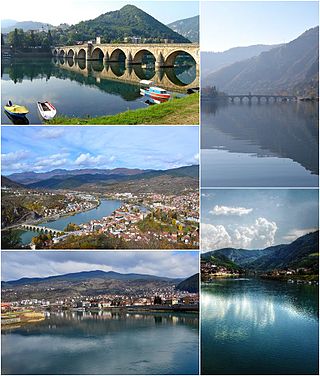
Doboj is a city in Republika Srpska, Bosnia and Herzegovina. It is situated on the banks of the Bosna river, in the northern region of Republika Srpska. As of 2013, it has a population of 71,441 inhabitants.

Republika Srpska is one of the two entities within Bosnia and Herzegovina, the other being the Federation of Bosnia and Herzegovina. Situated in the northern and eastern regions of the country, it recorded a population of 1,228,423 in the 2013 census. Its largest city and administrative hub is Banja Luka, located on the banks of the Vrbas River.

The national flag of Bosnia and Herzegovina contains a medium blue field with a yellow right triangle separating said field, and there are seven full five-pointed white stars and two half stars top and bottom along the hypotenuse of the triangle.

Bijeljina is a city and municipality in Republika Srpska, Bosnia and Herzegovina. It is the provincial center of Semberija, a geographic region in the country's northeast. As of 2013, it has a population of 107,715 inhabitants.

The Serbs of Bosnia and Herzegovina, often referred to as Bosnian Serbs or Herzegovinian Serbs, are native and one of the three constituent nations of the country, predominantly residing in the political-territorial entity of Republika Srpska. Most declare themselves Orthodox Christians and speakers of the Serbian language.

Yugoslav Railways, with standard acronym JŽ, was the state railway company of Yugoslavia, operational from the 1920s to the 1990s, with its final incarnation transferring to Serbia. The successor of JŽ is the joint stock company of the Serbian Railways in 2006.

Višegrad is a town and municipality in Republika Srpska, Bosnia and Herzegovina. It rests at the confluence of the Drina and the Rzav river. As of 2013, the municipality has a population of 10,668 inhabitants, while the town of Višegrad has a population of 5,869 inhabitants.

This article is about the Demographic history of Bosnia and Herzegovina, and deals with the country's documented demographics over time. For an overview of the various ethnic groups and their historical development, see Ethnic groups in Bosnia and Herzegovina.

The Belgrade–Bar railway is a 476.59 km (296.14 mi) long electrified main line connecting the Serbian capital of Belgrade with the town of Bar, a major seaport in Montenegro. Completed in 1976, which connects Belgrade with the Mediterranean port of Bar. It was built by the Yugoslav State Railways (JŽ) in 25 years of construction and is now operated by its successor companies Železnice Srbije (ŽS), Željeznice Republike Srpske (ŽRS) and Željeznička Infrastruktura Crne Gore (ŽICG).

Novo Goražde is a municipality in Republika Srpska, Bosnia and Herzegovina. Its center is the village of Kopači. As of 2013, it has a population of 3,117 inhabitants.

Serbian Railways is a Serbian engineering and technical consulting company based in Belgrade, Serbia. In 2015, the Government of Serbia established three new companies which took over Serbian Railways' former jurisdictions: Srbijavoz, Srbija Kargo and Serbian Railways Infrastructure. These companies are not part of the company Serbian Railways.

Rail transport in Montenegro is operated by four separate companies, which independently handle railway infrastructure, passenger transport, cargo transport and maintenance of the rolling stock. The four companies were a part of public company Railways of Montenegro until it was split up in 2008.

Dobrljin is a village in the municipality of Novi Grad, Republika Srpska, Bosnia and Herzegovina.

The Republika Srpska football team is the official team of Republika Srpska, an entity within Bosnia and Herzegovina. It is not affiliated with FIFA or UEFA.

Railways of Republika Srpska is the railway company of Republika Srpska, Bosnia and Herzegovina. It is one of the two rail companies in the country. The company operates 424 kilometres (263 mi) of railroad.

Railways of the Federation of Bosnia and Herzegovina is the railway company of the Federation of Bosnia and Herzegovina. It is one of the two rail companies of Bosnia and Herzegovina. The company operates 608 km of railroad.

Mostar railway station is a railway station located in Mostar, Bosnia and Herzegovina, in the eastern part of the city, near the Carinski Bridge, on Maršala Tita Street. The terminal also includes a bus station.

Most Serbian railway lines were built as a result of an expansion of railway networks by Austro-Hungarians. Several 760 mm gauge railways were planned to link the extensive narrow-gauge railways in the Austro-Hungarian Empire with those in Bosnia and Herzegovina. Until the outbreak of the Balkan Wars in 1912 several of these were constructed, the first ones in Eastern Serbia:

The Ohrid line was a narrow gauge railway line in what is now the Republic of North Macedonia. It ran to a gauge of 600 mm.

Sarajevo main railway station is a railway station in Sarajevo, the capital of Bosnia and Herzegovina, located in the northwest part of the city, approximately 3 kilometers from the downtown area near Marijin Dvor.























